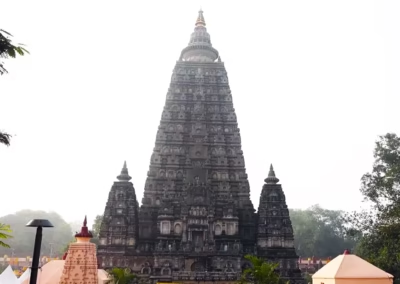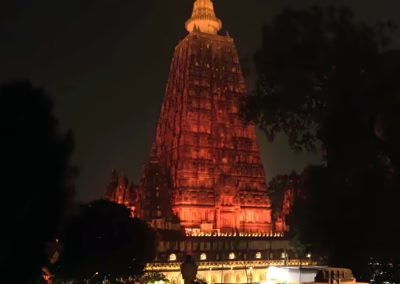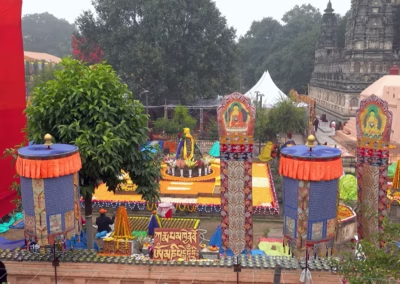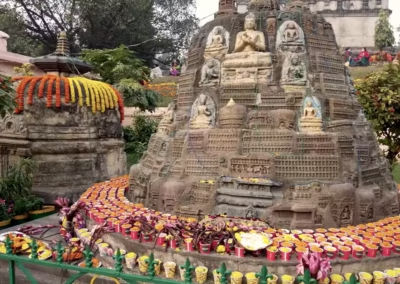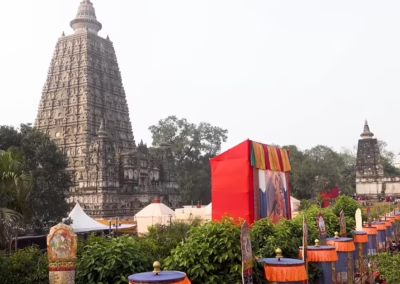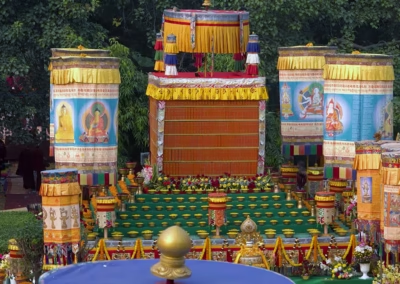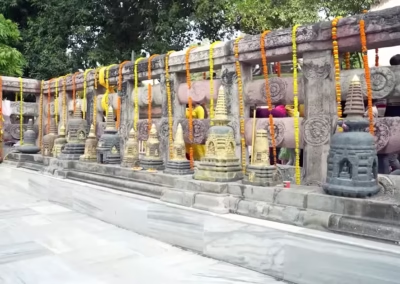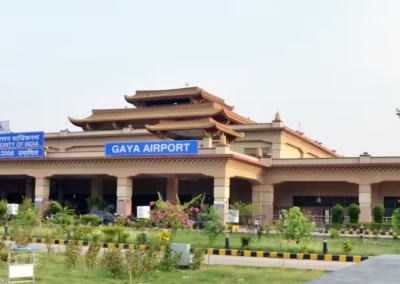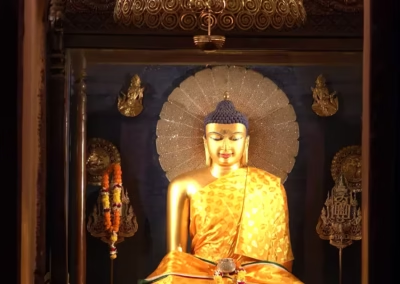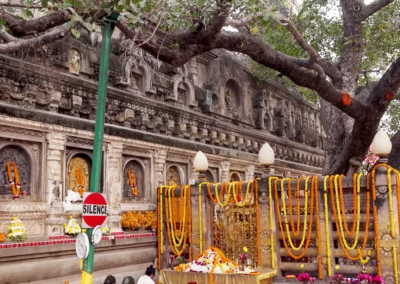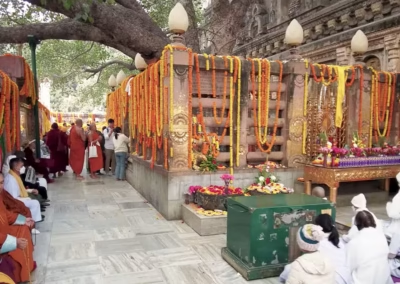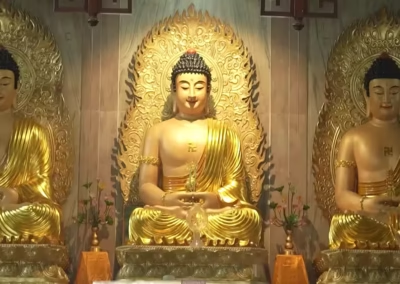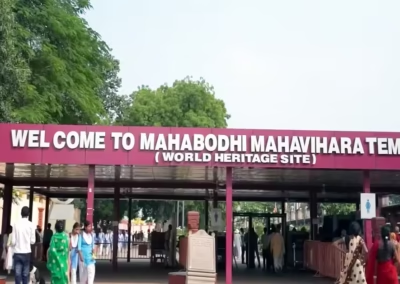Table of Contents
- 1 Introduction to Bodh Gaya
- 2 Why is Bodh Gaya important?
- 2.1 The Bodh Gaya Birthplace of Enlightenment
- 2.2 Bodh Gaya Temple an Ancient Religious Monuments
- 2.3 Bodh Gaya Temple Recognition as UNESCO World Heritage
- 2.4 Bodh Gaya Global Center of Buddhist Pilgrimage & Culture
- 2.5 Influence on Buddhist Philosophy & Nonviolence
- 2.6 Bodh Gaya Heritage, History & Restoration
- 3 Where is Bodh Gaya Located?
- 4 How to Reach Bodh Gaya Temple?
- 5 Bodh Gaya Tourist
- 6 Key Features of Bodh Gaya's Mahabodhi Temple Complex
- 7 🕊 Rituals and Ritual Life Beneath the Bodhi Tree
- 8 Construction History of Bodh Gaya: From Ashoka to Gupta and Beyond
- 9 Visitor Facilities at Bodh Gaya: What Pilgrims Can Expect
- 10 Precautions & Guidance for Visitors at Bodh Gaya
- 11 Summary
- 12 📚 Sources & References
- 13 Visitor FAQs Aboud Bodh Gaya – Quick Answers
- 14 Bodh Gaya, Mahabodhi Tree Pictures
- 15 Bodh Gaya and Mhabodhi Temple Google Map
Introduction to Bodh Gaya
Bodh Gaya, Mahabodhi Temple previously known as Uruvela and Vajrasana, is the sacred site where Siddhārtha Gautama—who became the Buddha—attained enlightenment under the Bodhi Tree around the 5th century BCE. By the 3rd century BCE, Emperor Ashoka erected the Diamond Throne (Vajrasana) and the first temple, affirming its continuing spiritual importance. While the original structure of Bodh Gaya temple is no longer present, the current temple dates back to the 5th-6th centuries CE and is supposed to incorporate elements of the earlier structure.
Over centuries—through Gupta-era rebuilding, invasion, and preservation—Bodh Gaya became a continuous pilgrimage center. It earned UNESCO World Heritage status in 2002 for its ancient architecture and meaningful association with enlightenment.
Why is Bodh Gaya important?
Bodh Gaya holds paramount importance in Buddhist tradition and global heritage. Here’s a clear breakdown of why it is so deeply revered:
The Bodh Gaya Birthplace of Enlightenment
The Buddha’s Awakening (Ānanda’s moment): Around the 5th century BCE, Prince Siddhārtha Gautama attained enlightenment under the sacred Bodhi Tree at Bodh Gaya, becoming the Buddha—marking the very origin of Buddhist doctrine.
This sacred moment—when he realized the Four Noble Truths and the Eightfold Path—cemented Bodh Gaya’s status as the ultimate spiritual epicenter for Buddhists worldwide.
Bodh Gaya Temple an Ancient Religious Monuments
Vajrasana (Diamond Throne): This polished sandstone slab, believed placed by Emperor Ashoka around 250 BCE, marks the exact spot of the Buddha’s meditation.
Mahabodhi Temple: The current brick structure dates back to the Gupta period (5th–6th CE) and remains one of India’s oldest surviving brick temples. Its soaring spire—over 50 meters tall—is an architectural marvel.
Bodhi Tree Descendant: Believed to be a direct scion of the Buddha’s original tree, this living monument sanctifies the sacred grounds and continues to be the object of veneration.
Bodh Gaya Temple Recognition as UNESCO World Heritage
Mahabodhi Temple Complex was granted UNESCO World Heritage status in 2002 due to its “outstanding universal value”, authenticity, and historical integrity.
UNESCO acknowledges that this site has retained its spiritual essence for centuries, reflecting its incredible preservation of form, function, and religious stature.
Bodh Gaya Global Center of Buddhist Pilgrimage & Culture
Pilgrimage magnet: Bodh Gaya attracts 2–3 million visitors annually, including monks, nuns, and lay pilgrims from Thailand, Japan, Sri Lanka, Tibet, Bhutan, and beyond.
International monasteries: Over 40 monasteries built by foreign Buddhists dot the town, representing varied schools of practice—from Theravāda to Chan and Vajrayāna.
Dharma headquarters: Bodh Gaya serves as a vibrant hub for global Buddhist exchange—hosting councils, festivals, and meditation retreats that strengthen spiritual unity.
Influence on Buddhist Philosophy & Nonviolence
Universal impact: The awakening here nurtured Buddhism’s spiritual reach across Asia, inspiring figures like Gandhi, Martin Luther King Jr., and Nelson Mandela in their commitment to ahimsa (non-violence) and justice.
Beacon of peace: Bodh Gaya remains a symbol of inner transformation and compassion—making it a sacred “beacon for world peace” in a turbulent world.
Bodh Gaya Heritage, History & Restoration
Enduring architecture: Despite medieval abandonment and damage, the Mahabodhi Temple survived, thanks to restorations by the British (19th century) and Burmese Buddhists.
Plateau of learning: Archaeological and historical evidence indicate the site was a major Buddhist teaching center from the Mauryan through the Pala dynasties.
Living site: Today, the Bodh Gaya Temple Management Committee manages ongoing conservation efforts, crowd control, and eco-friendly upgrades like solar lighting.
| Why Bodh Gaya Matters | Insight |
| 🌸 Core Buddhist Event | The Buddha’s enlightenment—defining moment in spiritual history. |
| 🏺 Ancient Markers | Vajrasana, Bodhi Tree, and monumental temple represent sacred milestones. |
| ✅ Heritage Endorsed | UNESCO-listed site with global cultural recognition. |
| 🌍 Global Pilgrimage Hub | Draws millions and fosters worldwide spiritual engagement. |
| 🕊 Peace Symbol | Embodies ahimsa and nonviolence worldwide. |
| 🔧 Well-Preserved & Active | Sustained through historic restoration and modern stewardship. |
In short, Bodh Gaya is the spiritual epicenter of Buddhism, where the Buddha reached awakening. It combines timeless religious significance with living tradition, architectural heritage, and global spiritual influence—making it the heart of Buddhist pilgrimage, peace practices, and historical reflection.
Where is Bodh Gaya Located?
Region & Coordinates of Bodh Gaya: Bodh Gaya is nestled in the Gaya district of Bihar, India, a small pilgrimage town with immense spiritual resonance. It’s situated at approximately 24°41′46″ N latitude and 84°59′29″ E longitude, or in decimal form, 24.6951 N, 84.9913 E, on the flat alluvial plains west of the Phalgu (Niranjana) River. Lying around 115 km south of the state capital Patna and a mere 15–16 km from the Gaya town center, the site is easily identifiable on maps and retains a compact urban sprawl of fewer than 20 km².
How to Reach Bodh Gaya Temple?
Bodh Gaya offers a surprisingly comprehensive network of transport options, making it well-suited for both local pilgrims and overseas visitors.
✈️ By Air: The closest airport is Gaya International Airport (GAY), located just 7 km northwest of Bodh Gaya town. It operates international flights from major Buddhist nations—such as Thailand, Sri Lanka, and Bhutan—alongside domestic connections to Patna and Delhi. In the year April 2024–March 2025, the airport handled 329,304 passengers, a 2.8% annual growth.
🚉 By Rail: The major access point is Gaya Junction railway station, about 16 km away and well-served by the Grand Chord line linking New Delhi and Howrah (Kolkata), including direct and express services such as the Mahabodhi Express. The station offers modern amenities like AC waiting lounges, reservation counters, and parking.
🚌 By Road: Bodh Gaya is connected to Patna (110–115 km north) and Gaya town via well-maintained highways, serviced by the Bihar State Tourism Development Corporation (BSTDC) and private buses, as well as auto-rickshaws and shared cabs at both airports and stations. Widening of key roads like Patna–Dobhi–Gaya and four-laning initiatives aim to sustainably improve access and shorten travel times.
Bodh Gaya Tourist
Visitor volume: Bodh Gaya welcomes between 2–3 million annual visitors, including Buddhists from Thailand, Japan, Sri Lanka, and global tourists.
Recent data: In late 2023, 687,644 tourists visited from April to October, averaging 3,213/day and surging to 10,269/day in peak September.
Local tourism reaches new heights: Gaya/Ji received ~800,000 tourist visits in 2023, prompted by improved infrastructure.
Future potential: With the upcoming Buddhist Meditation & Experience Centre under India’s Swadesh Darshan 2.0 scheme, Bodh Gaya targets even higher pilgrimage traffic.
Key Features of Bodh Gaya's Mahabodhi Temple Complex
Dolomite’s centerpiece: the Mahabodhi Temple
- Dominant structure: A towering 55 m brick temple from the late Gupta period (5th–6th century CE), making it one of eastern India’s oldest surviving brick monuments.
- Architectural style: Surrounded by four miniature towers and enveloped by sandstone and granite railings featuring lotus, Hindu deities, and stupa reliefs.
Vajrasana & Bodhi Tree
- Ashoka’s throne: Built circa 260 BCE to mark the spot of Buddha’s enlightenment, made of polished sandstone and protected by Gupta- and Kushan-era structures.
- Sacred sapling: The Bodhi Tree is grown from a descendant of the original Sri Maha Bodhi in Sri Lanka, doubling its religious resonance.
Surrounding Sanctuaries & Votive Stupas
- The site spans 4.86 hectares, including seven key enlightenment relics, numerous votive stupas, and remains of ancient monasteries.
- Buried treasures: Satellite imagery reveals concentric defensive walls and possible buried monasteries under the existing complex.
Additional Sacred Landmarks
- Lotus Pond, Ashoka Pillar, and multiple Buddhist monasteries commissioned over centuries by foreign royalty, expanding spiritual heritage.
🕊 Rituals and Ritual Life Beneath the Bodhi Tree
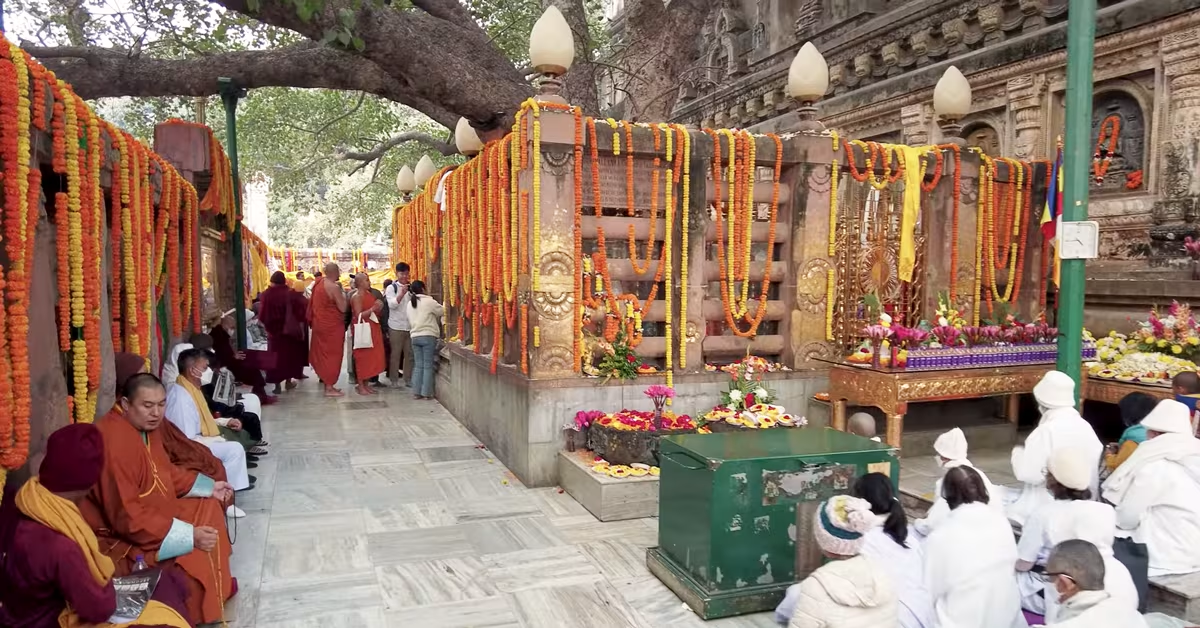
The Bodhi Tree is the spiritual heart of Bodh Gaya, and pilgrims engage in deeply symbolic rituals here:
Circumambulation (Pradakshina): Walking in a clockwise circle—often around the Bodhi Tree, Vajrasana, or Mahabodhi Temple—is a moving meditation and devotion. Many go for 3, 7, 21, or 108 circuits, silently chanting or reciting mantras. This act is believed to “cleanse the soul, purify intentions, and establish a mindful connection with the Buddha’s awakening”.
Prostrations: Numerous pilgrims—especially from Himalayan traditions—perform full prostrations often in the thousands, kneeling and bowing toward the tree or Vajrasana. This is a powerful expression of humility, renunciation, and reverence.
Offerings & Devotions: Pilgrims present flowers, candles, butter lamps, incense sticks, water bowls, and fruits. Evening rituals often include hundreds of lights encircling the Vajrasana—a ritual that visually embodies devotion and aspiration for liberation.
Chanting & Sutra Recitations: Throughout the day, monks and lay practitioners from diverse traditions gather to recite sutras or mantras. Major events like Kagyu Monlam (Tibetan prayer festival) and continuous Pali Tipitaka chants draw thousands, fostering vibrant exchanges of spiritual practice.
Meditation & Pilgrimage Experience under the Bodhi Tree
Personal & Group Meditation: Pilgrims commonly meditate beneath the Bodhi Tree, in front of the Vajrasana, or within the temple courtyard—especially during dawn (5–7 AM) and early evening (5–7 PM) when calm and spiritual energy are highest. Both guided retreat-style sittings and solo silent meditation are facilitated. Numerous temples on-site offer formal retreat programs:
- Theravāda Vipassana centers
- Tibetan meditation retreats
- Zen/Chan temple sittings.
Pilgrim Tools & Insight:
Meditation cushions and simple mats are sometimes available. Many pilgrims carry their own, though basic support is offered at rest houses and guest monasteries.
Life & Structure at Bodh Gaya Monasteries
Bodh Gaya hosts over 40 international monasteries—each representing regions like Thailand, Japan, Korea, Tibet, Bhutan, and Sri Lanka. These monasteries:
- Provide daily chanting, meditation sessions, and Dharma talks.
- Offer guest accommodations—often donation-based—for pilgrims.
- Celebrate international Buddhist festivals—Vesak, Bodhi Day, or Kagyu Monlam—as global spiritual communities.
Monks maintain spiritual discipline, while lay volunteers manage visitor services and ceremonies.
Upgraded Facilities: The Buddhist Meditation & Experience Centre
As part of India’s Swadesh Darshan 2.0, the Bihar government approved a Rs 165 Crore (US $20 Million) project to erect an immersive Meditation & Experience Centre in Bodh Gaya.
Key Features:
- Location: Spanning 8.5 acres at Node I, plus a 7-acre extension in Domuhan.
- Design: Crafted on inspiration from the Kesariya Stupa, it will echo ancient Buddhist aesthetics.
- Facilities: Meditation halls, digital interactive exhibit zones, quiet reflection spaces, and areas for group practice.
- Goals: Enhance spiritual tourism, attract international pilgrims, create jobs, and generate revenue for local communities.
Current Status:
- Technical approval granted April 2, 2025
- Administrative/government approval on May 16 & 22, 2025
- Initial Rs 16.5 Crore deployed, with BTSDC leading implementation and ITDC overseeing monitoring.
Why This Matters for Bodh Gaya and Mahabodhi Temple?
- Enhancing Pilgrim Experience: The new center will allow visitors to delve deeper into meditation and Buddhist philosophy—with explanation spaces, retreat-style architecture, and technology-enabled learning.
- Supporting Local Communities: Visitor services, cultural exchange, and hospitality linked to the center aim to uplift local socio-economic conditions.
- Preserving Spiritual Heritage: Planned expansion ensures the interface of ancient rituals and contemporary needs is thoughtfully managed, preserving Bodh Gaya’s sanctity.
Bodh Gaya remains a living pilgrimage center, anchored by the Bodhi Tree’s rituals of circumambulation, prostrations, and world-scale chanting. Meditation—both solitary and communal—is woven into daily life, fostered by global monasteries. Significantly, the upcoming Meditation and Experience Centre signals a forward-thinking vision: a bridge between ancient enlightenment and modern spiritual seekers, with thoughtful infrastructure and deep cultural integration.
Construction History of Bodh Gaya: From Ashoka to Gupta and Beyond
3rd century BCE: Emperor Ashoka’s initial efforts to sanctify the site with foundational structures such as the Vajrasana, stupa enclosures, and temples.
Gupta era (5th–6th century CE): Construction of the current Mahabodhi Temple’s main tower and ornate railings, reflecting a golden age of Buddhist architectural flourish.
Medieval guardianship: Ruled by the Pithipati dynasty (1120–1290 CE), the site regained vibrancy under Acarya Buddhasena’s patronage before invasions damaged parts of the complex.
Rediscovery & restoration: Revitalized by Sir Alexander Cunningham and Xuanzang’s records in the 19th century; reconstructions continue into modern times.
Conservation initiatives: Ongoing UNESCO-driven restoration & structural maintenance protect the temple, while government support helps upgrade visitor infrastructure.
Area Covered: Size & Layout of Bodh Gaya
Spanning 4.86 ha, Bodh Gaya features multi-level rail pathways built 5 m below surrounding terrain.
The three concentric sacred enclosures, including a traditional lotus pond, host extensive green spaces and meditation zones.
The entire Bodh Gaya pilgrimage zone, including monasteries and paths, sprawls over several square kilometers beyond the main complex.
Visitor Facilities at Bodh Gaya: What Pilgrims Can Expect
Pilgrim Accommodations
- Monastic guesthouses: Bhutanese Resthouse, Tibetan Resthouse, Mahabodhi Resthouse—functioning on donations and hospitality.
- Hotels & lodges: Range from luxury stays to budget dharmashalas and private guesthouses in town.
Meditation & Spiritual Learning
- Global monasteries: Thai, Tibetan, Japanese, Korean, Sri Lankan, and Chinese temples offer teachings, chanting, and retreats.
- Soon: Meditation Centre: Soon opening under Swadesh Darshan, with meditation halls, libraries, and cultural exhibits.
Infrastructure & Amenities
- Transport links: Airport, railway, and well-maintained roads from major cities.
- Pilgrim support: Tourist offices, vehicle rental, ATMs, Wi‑Fi zones, translation services, and medical aid.
- Commercial services: Cafes (like Be Happy, Tibet Om), vegetarian restaurants, monk-friendly dining options.
Precautions & Guidance for Visitors at Bodh Gaya
Security measures: Enhanced since 2013 bombing; police presence around Bodhi Tree; bag checks and restricted zones.
Cultural respect: Modest attire, shoe removal before shrines, respectful silence during prayers, no touching of sapling.
Weather awareness: May–June heat up to 45 °C; heavy monsoon rains June–Sept; best visiting Indian winter (Oct–Mar).
Health & safety: Stay hydrated, use sun protection, cataract-friendly sunglasses, avoid peak afternoon hours for outdoor walking.
Crowd control: Festivals like Buddha Purnima draw heavy crowds—use official guides and arrive early.
Summary
Bodh Gaya is not just another destination—it is the epicentre of Buddhism, the site of the Buddha’s enlightenment, and a historic pilgrimage hub continuing for 2,500 years. From Ashoka’s early sanctifications to the Gupta empire’s architectural marvel, to modern restoration and visitor-tech facilities, this UNESCO site offers pilgrims and tourists a profound journey.
With 2–3 million annual visitors, planned meditation infrastructures, and modern amenities, Bodh Gaya offers deep spiritual immersion combined with thoughtful pilgrimage support—while sustainable growth ensures this sacred ground remains respected and accessible.
📚 Sources & References
- Bodh Gaya – Wikipedia
- UNESCO: Mahabodhi Temple Complex (whc.unesco.org)
- HolyVoyages Bodh Gaya FAQ & visitor stats (holyvoyages.com)
- Smarthistory: pilgrimage town overview (smarthistory.org)
- Times of India, Hindustan Times, NDTV – visitor data & infrastructure
- Pilgrimaps, BuddhistTourism.online – monastery features (pilgrimaps.com)
- Multiarticles Journal – donation guesthouses (multiarticlesjournal.com)
- On-site rituals, meditation practices, and monastery life: U.S. Tirumala Info, Vidzone, Enlightenment Journey sites (vidzone.in)
- Upcoming Meditation & Experience Centre details: PatnaPress, Times of India, Club Mahindra (clubmahindra.com)
- Reddit pilgrim testimonials: experiences, meditation stays, food
Visitor FAQs Aboud Bodh Gaya – Quick Answers
How many tourists visit Bodh Gaya annually?
Approximately 2–3 million visitors, with over 680,000 between April and October 2023.
What are the must see sites at Bodh Gaya?
Mahabodhi Temple, Bodhi Tree (Vajrasana), Lotus Pond, Ashokan Pillar, and international monasteries.
When is the best time to visit Bodh Gaya?
The best time to visit Bodh Gaya is October to March—cooler and dry; peak festivals: Buddha Purnima (May).
Are there meditation retreats in Bodh Gaya?
Yes—various monasteries offer retreats, and a major Meditation & Experience Centre is set to open in 2025.
What amenities are available for pilgrims?
Guesthouses, cafés, medical aid, toilets, Wi‑Fi, language support, souvenir shops, and ATM access.

